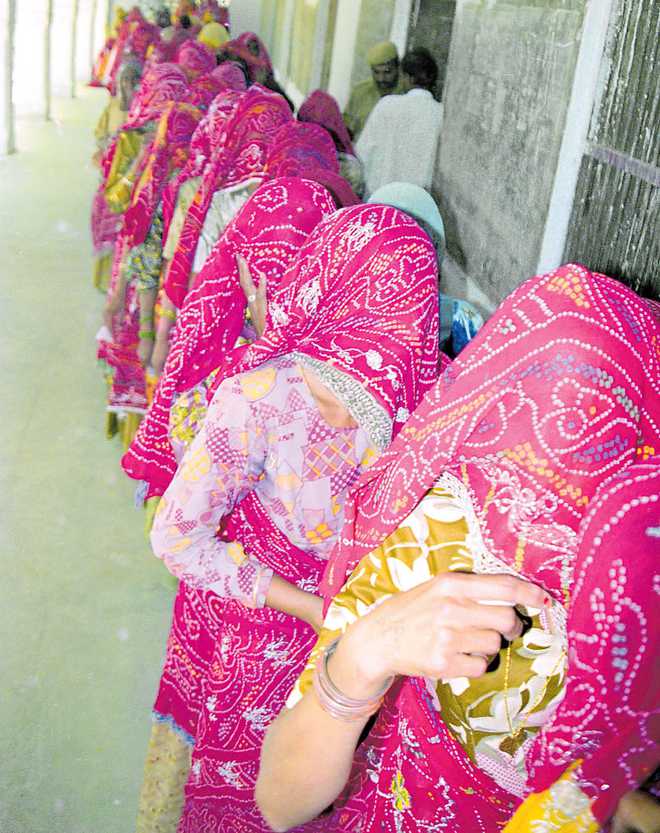THERE is a deeper truth behind the June publication of Haryana government's official Haryana Samvad magazine carrying a photograph of a woman in a ghunghat or veiled face with cattle-feed on her head and a caption: Ghoonghat ki aan-baan, mahra Haryana ki pechchan (pride of the veil is the identity of my Haryana). Ram Bilas Sharma, the Education Minister said, “The ghunghat is part of our culture and I am proud of it”. A “non-ghunghated” minister, Kavita Jain, supported it vehemently. Chief Minister Manohar Lal Khattar white-washed it, saying it will be investigated. All is quiet on the ghunghat front.
The image represents a contradictory visual image of women in Haryana that clearly the power-wielders, as representatives of others with a similar opinion, wish to retain — participation of rural women in the dominant economic activities albeit in a ghunghat. Haryanvi women are involved in field work, alongside men — from preparing fields to irrigating and harvesting the crop. Women process agricultural produce, tend animals, fetch and carry water with heavy earthen pots on their heads. Their seclusion in agriculture is economically not viable for men.
A woman in ghunghat is projected as being central to the dehati (rural) culture, as also its sole custodian. Stripping away of the veil is imagined to be leading to the collapse of the rural social fabric and culture, perceived as opposed to the “other” or “urban culture.” The uncovered urban woman elicits pejoratives epithets. As opposed to this, a woman in a ghunghat is stated to offer izzat (honour) to those before whom it is observed and to indicate a woman of sharam-lihaaz (modesty and deferential behaviour). The ghunghat imposes efficacious constraints upon women, making them ineffective in crucial spheres. It inflicts the most cogent control on married women, extending from their private and public conduct in purely domestic and private familial sphere to the political structures of the wider village community. Social distance and patterns of avoidance regulate behaviour and limit interaction of women with those who control economic resources, wield power and make decisions.
Extreme insecurity is being felt by the patriarchal forces which are becoming more and more anxious to control women. This insecurity emanates from the post-colonial politico-legal and social changes that have had profound effects. These relate to granting equal rights of inheritance, marriage and divorce, open defiance of the practice of remarriage of widows. Availing of these rights has created havoc in Haryanvi society. Growing instances of run-away marriages has led to the increasing role of judiciary, specially the higher judiciary. Couples are defying age-old customs and revolting against imposed constrictions due to growing urbanisation, education and higher mobility due to economic opportunities. These have altered local power dynamics, complicating relationships between members of different communities, and a globalised and consumerist societ — all of which has increased the intermingling of sexes that challenge rural societal norms and customary practices. These also challenge patrilineal interests and enhance the stakes to control women strictly.
The single-most important change, which has had a profound effect is the enormous increase of land prices in Haryana due to 30.46 per cent of its total area being brought under the National Capital Region. With the price of one acre of land running into crores, it has caused a rethink among women regarding claiming of their share, Legally enabled, they are staking claims to the share of property in rural Haryana and upsetting customary norms. Government measures have had a similar effect. Concession in the stamp duty to women property buyers was introduced in 2005. The property registered in a woman’s name has a stamp duty of 5 per cent as compared to 8 per cent for a man. This has led to a substantially large number of women being made property owners. Even if transferred by male owners either as a gift deed or purchase of immovable property in the name of the wife or the mother, etc. for tax purposes, the act of ownership gives the woman a fair degree of weightage as also some say in decision-making. There are known instances where women have asserted themselves and used it to wield a certain level of economic authority.
There are instances of giving up of ghunghat by individual rural women. A female school teacher in village Dujjana disclosed that she bought a bicycle out of her salary to go to school in an adjoining village like other women. As soon as she and others were outside the village boundaries, they lifted their ghunghats. With this gesture, they joined the ranks of those panchayat members who gave up wearing the ghunghat. Such a lifting allows a woman interact directly with her male counterparts and to influence their decision making.
The reaction to all these changes has been extreme insecurity. The recent sprout in the cases of “honour killings”, consolidation of regressive traditional forces in the form of khap panchayats and their renewed demands to do away with the laws that have given property rights to women or legalised her choice marriage, regardless of caste and community considerations, cause an anxiety to control.
“Modern” and “progressive” socio-political and legal norms have evoked the “conservative” and “non- progressive”, as evident in the published image of women. It is undoubtedly related to an attempt to contain the mounting pressure of internal and external demands. But for how long? The challenges of a changed society, and its varied demands, patterns of behaviour, expectations, and different points of reference for culture, both for men and women are becoming more and more visible.
The writer, a historian and contemporary social analyst, has authored many books on Haryana
Unlock Exclusive Insights with The Tribune Premium
Take your experience further with Premium access.
Thought-provoking Opinions, Expert Analysis, In-depth Insights and other Member Only Benefits
Already a Member? Sign In Now










